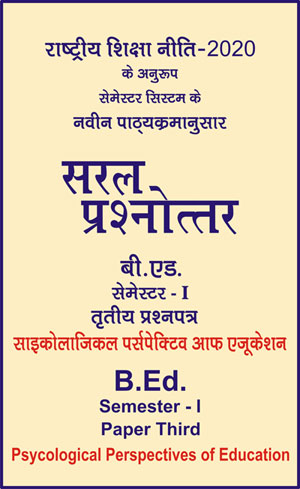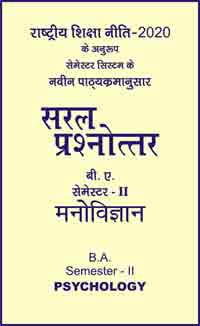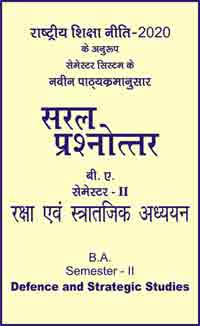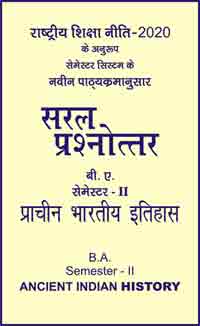|
बी एड - एम एड >> बी.एड. सेमेस्टर-1 प्रश्नपत्र-III - साइकोलाजिकल पर्सपेक्टिव आफ एजूकेशन बी.एड. सेमेस्टर-1 प्रश्नपत्र-III - साइकोलाजिकल पर्सपेक्टिव आफ एजूकेशनसरल प्रश्नोत्तर समूह
|
5 पाठक हैं |
|||||||
बी.एड. सेमेस्टर-1 प्रश्नपत्र-III - साइकोलाजिकल पर्सपेक्टिव आफ एजूकेशन (अंग्रेजी भाषा में)
Individual Differences
1. As a social science teacher, how would you view individual differences in your class?
(a) this will increase conflict between the teacher and students
(b) it hinders the learning process
(c) it creates a challenge for the teacher to involve all the learners
(d) it provides space to discuss wider perspective in the class
2. Individual attention to students is important in the classroom because it :
(a) helps the teacher to take care of individual differences between students
(b) it creates homogeneity in class
(c) it is taught in the teacher education programme
(d) it checks the teacher’s ability to handle individual differences successfully
3. Sarita, an English teacher, observed that her students show differences in learning what she teaches. So Sarita should
(a) follow a uniform way of teaching so that individual differences in learning are reduced
(b) make very strict rules for the students to follow
(c) incorporate a variety of experiences in her teaching to improve learning
(d) not worry about these differences
4. How can studying individual differences between students help a teacher?
(a) it will help develop a competitive feeling among his students
(b) it will help him to devise the best instructional strategies
(c) it will help him in avoiding cultural conflicts
(d) None of the above
5. What should be the role of the teacher in reducing the effects of individual differences?
(a) the teacher should try to adjust the curriculum as per the individual’s needs
(b) the teacher should try to understand the abilities, aptitudes, and interests of the students
(c) both (a) and (b)
(d) neither (a) nor (b)
6. Learners display individual differences, So, a teacher should :
(a) insist on a uniform pace of learning
(b) provide a variety of learning experiences
(c) enforce strict discipline
(d) increase number of tests
7. Schools should cater to individual differences to :
(a) make individual students feel exclusive
(b) narrow the gap between individual students
(c) even out abilities and performance of students
(d) understand why students are able or unable to learn
8. The individual differences of students in a classroom are :
(a) disadvantageous as teachers need to control a diverse classroom
(b) detrimental as they lead to student-student conflicts
(c) inexpedient as they reduce the speed of the curriculum transaction to the level of the slowest student
(d) advantageous as they lead teacher to explore a wider pool of cognitive structures
9. We all differ in terms of our intelligence, motivation, interest, etc., This principle refers to :
(a) individual differences
(b) theories of intelligence
(c) heredity
(d) environment
10. Regarding learners’ individual differences, the teacher should :
(a) solve the problems based on the deductive method
(b) use algorithms most of the time
(c) provide facts to students to memorize
(d) provide a variety of learning situations
11. Why do individuals differ from one another?
(a) because of the impact of the environment
(b) due to the inborn characteristics
(c) due to the interplay between heredity and environment
(d) because each individual has received a different gene set from his/her parents
12. To cater to individual differences in his classroom, a teacher should :
(a) segregate and label children based on their marks
(b) engage in a dialogue with students and value their perspectives
(c) impose strict rules upon his students
(d) have a uniform and standard ways of teaching and assessment
13. Research suggests that in a diverse classroom, a teacher’s expectations from her students .......... their learning.
(a) are the sole determinant of
(b) should not be correlated with
(c) do not have any effort on
(d) have a significant impact on
14. "Having a diverse classroom with children from varied social, economic and cultural backgrounds enriches the learning experiences of all students." This statement is :
(a) correct, because children learn many skills from their peers
(b) correct, because it makes the classroom more hierarchical
(c) incorrect, because it leads to unnecessary competition
(d) incorrect, because it can confuse the children and they may feel lost
15. The determinants of individual differences in humans relate to :
(a) differences in their environment
(b) differences in their heredity
(c) differences in both heredity and environment
(d) an interaction between the factors of heredity and factors of the environment
16. Which of the following is not an acquired trait of a learner?
(a) height
(b) cultural outlook
(c) education
(d) manners
17. The statement "Every learner is unique." means that :
(a) it is not possible to develop the learners' potential in a heterogeneous class
(b) learners do not share common goals
(c) making a common curriculum for all learners in a class is impossible
(d) no two learners are alike in their capabilities, interests, and talent
18. Sarla is usually not able to follow the examples given by her science teacher to explain a principle. The teacher tells her, "You do not even understand simple things." The teacher :
(a) motivates Sarla
(b) humiliates Sarla
(c) uses a differentiated method of instruction
(d) understands individual differences in her class
19. A teacher usually assigns different tasks to different students. She believes that :
(a) students do not like the same kind of work being assigned to all
(b) there exist individual differences between students
(c) it promotes competition among the students
(d) with this method, the students will not be able to copy each other’s work
20. It is necessary to value individual differences in the classroom because it is :
(a) necessary for proper development for all the children
(b) the learner’s right
(c) the teacher’s responsibility
(d) all of the above
21. The reason for a learner facing difficulty in understanding a lesson in a literature textbook is :
(a) not clear about the scope of the language
(b) not comprehending the structure of the language
(c) both (a) and (b)
(d) neither (a) nor (b)
22. Women are better than men in handling social responsibilities. This is due to difference in :
(a) gender
(b) culture
(c) aesthetic sense
(d) memory
23. Which one of the following may not be attributable to individual differences?
(a) social status
(b) cognitive abilities
(c) number of family members
(d) none of the above
24. A person having a highly structured attitude will Individual Differences among Learners :
(a) give a poor cognitive response to a stimulus
(b) give a quick cognitive response to a stimulus
(c) have feelings and beliefs which are in conflict with his/her attitude
(d) none of the above
25. Individual differences between two persons can be due to :
(a) dissimilarities between their personalities
(b) similarities between their personalities
(c) conflicts between them
(d) uniformity of personality among human beings
26. Variations in personality among different people are due to :
(a) their different experiences in life
(b) differences in their heredity
(c) both (a) and (b)
(d) neither (a) nor (b)
27. Ram understands a chapter quickly while Shyam takes much more time. This happens because :
(a) they are individually different
(b) Ram is more intelligent than Shyam
(c) Shyam’s grasping power is less than Ram’s
(d) all of the above
28. Variations in acquisition of manual skills are usually due to variations in :
(a) psychomotor speed
(b) the ability for and quickness in understanding procedures
(c) general intelligence
(d) all of the above
29. It is important for teachers to understand individual differences among learners so that :
(a) they can ensure that all students pass the examinations
(b) they can create an atmosphere taking care of the learner’s differences
(c) their work becomes easy
(d) they can create a happy classroom
|
|||||














